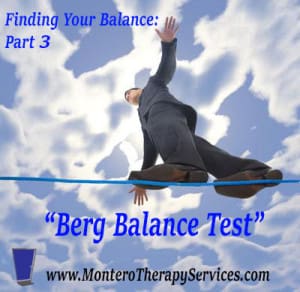Welcome to Part 3 of our “Finding Your Balance” Blog Series.
Just in case you missed our previous Blogs, Part 1: The Functional Reach Test, can be found by clicking here and Part 2: The Tinetti, can be found by clicking here.
Our goal with this Blog Series is to provide the therapist working in long-term care with a series of clinically relevent objective tests and measures that can be used in your department. For each of the tests reviewed here, we will give you:
- The “how to”
- The “pros and cons”
- The statistical measures
- The “norms” for the geriatric population
- A ready-to-use printout of a customized test form that you can use in your setting immediately
This objective data should be included in your clinical documentation and will support the necessity of your services and help support your goals and treatment plan. Not only that, but you will gain valuable insight into the specific limitations of your residents and be able to develop a natural progressive treatment plan to keep them on their feet! If you use an EMR, no worries, you can reference the test score in your electronic documentation and keep the paper copy in your soft chart. Remember, Medicare is looking for objective clinical data– so why not give it to them!!
A Quick Recap: Measuring Balance
When selecting a test to measure balance, there are multiple factors therapists consider, which ultimately help match up a test to our resident.
- How practical is the test?
- Is the test easy to administer?
- Can the test be incorporated into a treatment session?
- Is it cost effective?
- Is equipment required?
- Statistically is it a “good” test — is it reliable, valid, reproducible?
For our geriatric residents, there are also multiple additional considerations including: cognition, medications and interactions, sensory impairments, endurance and the severity of the balance impairment we are attempting to measure… just to name a few.
The Berg Balance Scale (BBS)
What Does It Measure?: Measures balance in a progressive sequence incorporating components used in other balance tests (ie: Tinetti, Functional Reach, Tandem Stand).
- The Berg Balance Scale (BBS) is considered by many to be the “gold standard” in balance assessment as it is one of the most studied tests with shown reliability and validity in published research.
- Consists of 14 items/tasks each scored from 0 to 4 for a perfect score of 56
- Items consist of Sit to Stand, Sitting, Transferring and Standing in various static and dynamic postures
How Long Does It Take?: 20 minutes
Equipment Needed?: Chair with arms; Chair without arms (or a bed); Step or stool; Stopwatch; Ruler; Object to retrieve from floor; 15 feet of space;
How To: See download below for step-by-step test instructions. Clinic-ready form has instructions and scoring – can be printed out for clinic use. Formal testing requires reading of directions to patient for each of the 14 items listed. Items are scored 0 to 4 and include:
- Sit to stand
- Standing unsupported
- Sitting without back support, feet on floor
- Stand to sit
- Pivot transfer to chair with and without arms
- Standing unsupported eyes closed
- Standing unsupported feet together
- Reaching forward while standing
- Picking up object from floor
- Turning to look over shoulders
- Turning 360 degrees
- Placing foot on step unsupported
- Standing tandem unsupported
- Standing on 1 leg
Norms:
- Community Dwelling Elders Age 80-89 at 49-54; Age 70-79 at 52-56; Age 60-69 at 54-56 (Steffen 2002)
- Residential Dwelling Elders 80+: Tested at mean score of 30 (Conradsson 2007)
Results:
- Score of 56 = Normal, full function, no fall risk
- Score of <45 indicates greater risk of falling
- Score of <40 indicates fall risk approaching 100%
Pros: Valid “Gold Standard”; Reliable measure of balance; Good fall risk predictor; Requires little space and equipment
Cons: Does not use assistive devices; Takes longer than some other tests; Studies found limited with SCI, vestibular dysfunction and Parkinson’s Disease
Print Out of Test and Documentation Form from the Toolbox
Documentation and Billing
The initial performance of the test can be incorporated into an initial evaluation or performed separately at any time during the course of treatment. If the test is performed on the initial evaluation, the score can be documented and used to establish short and long term goals for balance improvement, or “fall risk reduction.” Subsequent repeat performances of the test can be done during a treatment session and the time can be allocated to CPT 97112, neuro muscular re-education, a time-based code incorporating therapeutic procedures to improve balance, coordination, kinesthetic sense, posture, and proprioception. If you choose to use balance as a measure for your Functional Limitation Reporting, the G-Code Category “Changing and Maintaining Body Position” is appropriate, with G8981 for the Current Status, G8982 for the Goal Status and G8983 for the Discharge Status.
Treatment sessions can include portions of the test incorporated into treatment activities such as: standing unsupported, reaching, retrieving objects from the floor, turing 360 degrees, tandem standing, etc.
In Summary
Residents like to see evidence that they are progressing, and even though they may not have progressed to the next “level” of independence, the Berg Test allows them to see that they are performing tasks with less loss of balance, and that provides positive reinforcement to continue to progress toward goals. The Berg is an easy test to perform and is the gold standard of balance tests. Why not familiarize yourself with it today!
Whether you are screening residents for fall risk or providing treatment to residents with balance deficits, if you have not been using objective tests and measures for balance, the Berg is a great place to start!
Now Test-Away!
Any questions, Just Ask! by visiting our Q&A forum.
In Your Corner,
Dolores
*A special thank you to physical therapist extraordinaire, Laura Minnick, for contributions to this post.
